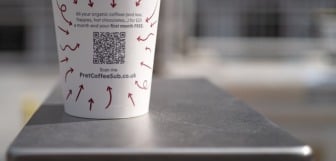QR Codes: How they Work, and How to Make a QR Code Menu
Since the pandemic, many hospitality businesses are turning to creating digital menus that can be accessed when customers scan a QR code. They’re a lot more hygienic than traditional physical menus, less costly than disposable paper menus, and they’re mobile-friendly, too.
Despite seeming slightly confusing and extremely technological, it’s very easy to make a QR code. There are also multiple uses and benefits of QR codes, which we’ll dive into later in the article. Keep reading to learn how to make a QR code menu for your hospitality business.
What is a QR code and how do they work?
QR (Quick Response) codes work very similarly to a barcode. The technical name for a barcode is a universal product code. These are placed on product labels and, if entered into the database correctly, will be read identically by every single computer that reads it. They use numbers and bars, and can be read if scanned top to bottom.
QR codes, on the other hand, are a lot more versatile. They’re a type of barcode that can be read by a digital device, and store information as a series of pixels in a square-shaped grid. Because QR codes don’t have numbers, and because of their square shape, they can store a lot more data than barcodes can. They can also be read in two directions, top to bottom and left to right.
Japanese car manufacturing company Denso Wave invented the QR code in 1994. They wanted to make a barcode that could be scanned from any angle to speed up operations and add convenience. They also wanted it to have a distinctive design to make it easy to identify. This led them to choose the iconic square shape that is still used today [1].
Today, QR codes are most commonly used to create a quick and convenient link to a website URL or an online PDF. If used in a hospitality setting, this means you can create a QR code that links customers directly to your online menu, or booking system, or app.
How to make a QR code for your business in 3 steps
Creating a QR code menu can be done in as little as 10 minutes, and cost about 10 pounds.
Step one: Make your menu available online
Upload the PDF version of your menu to your website that you’ve already created for your printed menus, or create a mobile-friendly landing page of your digital menu, and upload to your website. If you have already uploaded your menu to your website for showcasing reasons, make sure to include the prices on the menu since customers are using it in lieu of physical menus at their table.
Step two: Create QR codes
As this blog goes on to mention, there are multiple different types of QR codes you can include for a streamlined customer experience.
There are hundreds of free QR code generators online. You might want to pick one that allows you to add your logo, and customize your QR code to include your company colours.
You can also create a QR code for free using your point of sale (POS) if you’d like to offer contactless dining, which is where customers can view the menu, order and pay online. This service adds unprecedented layers of operational efficiency, payments process automatically, and orders are sent directly to the kitchen from the customer’s device.
Step three: Print and display QR codes
Most QR code generators offer a QR code that can be downloaded for free, or a higher-resolution version for under 10 pounds. It’s worth paying for a high-res version since they’ll scan better for customers.
Multiple uses for QR codes
You can put your QR code anywhere in your restaurant. We’ll provide a step-by-step guide to creating a QR code menu, but you should also consider some other creative ways to include them in your restaurant.
QR codes menu placement
For a fun and interactive service, include your restaurant menu QR code in various parts of the restaurant. You can place them on table tents, on the table itself, outside the building itself, and in the waiting area. This way, customers can quickly access the menu without waiting for staff intervention.
If you have a special Sunday menu, or a drinks menu, you could create unique QR codes for these for added customer convenience.
Of course, it’s best to have some physical menus on hand, but since about 90 percent of adults own a smartphone [1], it’s safe to assume that most will be able to access your digital PDF menu if they are walked through the process.
Online queueing system
If your restaurant is facing limited capacity and you don’t want to turn customers away, create an online queueing system that sends customers a message inviting them to return to your restaurant. It’s an idea that was popularised by restaurant chain Nandos during the pandemic, and it proved to be very effective.
Instead of simply asking customers to come back and try again in 20 minutes, they can scan a QR code that directs them to a landing page where they can fill in their contact information. They will then be added to a virtual queue, and sent a message when their table is ready. Place the QR code on a sign outside the building, explain the simple sign-up process, and continue turning over tables without the pressure of a crowded waiting area!
Marketing purposes
Add a QR code to takeout cups, posters, or receipts to drive repeat visits and attract more website traffic. This could also be a great way to encourage social proof of your restaurant. Create links to your website URL, social media page, or to a specific voucher code that can be redeemed in the restaurant.
What are the benefits of adding QR codes to your business?
There are a number of benefits of adding QR codes to your business.
Convenience
QR codes can add ample layers of convenience to your business for both staff and customers. For one, customers can access your menu without waiting for a server to physically hand them one to read.
Efficiency
Adding contactless QR can alleviate servers and hosts from a lot of their duties, allowing them to focus their attention on other areas of the restaurant. This way, staff can spend more time interacting with guests and proving better customer service and experience, rather than carrying out tasks that can be automated with QR.
Cost
A digit menu that can simply be amended online is a lot cheaper than reprinting and replacing physical menus. Since staff can also work more productively, this too will impact the table turnover rate, which should impact overall profitability over time.
Sanitary reasons
Reduce touch points and handling of physical menus by offering a contactless solution. Despite many restaurants using QR codes for years, they’ve grown in popularity over the past two years during the pandemic. As well as an online menu, you can also include a separate QR code for track and trace purposes as well.
Create the restaurant of the future, today
With an Epos Now Restaurant POS, you can find more ways to satisfy customers by offering simplified tableside ordering, delivery, contactless payments, and more.
- Track time-at-table and manage floor plans in real-time to boost table turnover
- Streamline back of house operations with a comprehensive Kitchen Display System
- Group by course and order type to speed up preparation and reduce customer wait times
- Pass orders directly to your kitchen to improve order turnaround times and accuracy
- Receive online orders through into your kitchen as soon as they come in
- Eliminate manual paper tickets and confusion to improve service
- Respect social distancing and reduce the need for staff to manually submit orders to the kitchen
- Remove errors with a single view to any last-minute order changes




